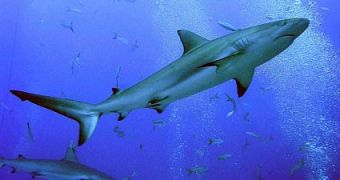There are more and more mysteries about the sharks' reproductive abilities, besides the already known facts, like the double penis and the siblings' intrauterine cannibalism. Recently, the first case of asexual reproduction (parthenogenesis) among sharks has been documented, a hammerhead female shark at a Nebraska zoo having given birth without receiving sperm from a male.
Now veterinarian Bob George at the Virginia Aquarium & Marine Science Center in Virginia Beach, has found in a blacktip reef shark a perfectly formed, 10-inch (25 cm)-long shark pup, almost ready to be born. The question was: how did the mother get pregnant, being the only one of her species in the tank? "We must have had hanky panky in the shark tank," he thought.
Sharks are known to only breed with those of the same species. So, there were two possibilities: the embryo was a hybrid, the first known shark hybrid, or a clone resulted through parthenogenesis. Tissue samples from the female and its pup are now being examined for DNA, but the results can take months. It would be the second known case of shark parthenogenesis, if foreign DNA is not found.
The 5 ft (1.5 m) and 94 pound (40 kg) female had lived in the aquarium for almost 10 years, swimming with other shark species in a 300,000-gallon tank. "Blacktip reef sharks are sensitive to change, so it was standard procedure to give Tidbit a sedative. This time, Tidbit went under the sedation too deeply - maybe because of a combination of the unknown pregnancy and the stress of being handled and of having recently been bitten by another shark", George said.
As there was no reason to believe the female was pregnant, the pup likely would have been born and immediately eaten by another shark, without aquarium employees ever knowing of the event, and this could happen often in shark tanks. Thus, an accidental death could lead to solving a mystery of nature.
Parthenogenesis is common in many insects, some lizards and fish, and only recently found in sharks. While normally an egg is fertilized by sperm, resulting an embryo containing half of the chromosomes coming from the mother and half from the father, in parthenogenesis, an egg's DNA coming from the mother doubles, so that the embryo has a full chromosomes set from the female, without DNA from a father.
In the case of sharks, "this is probably something that does happen in aquariums, more often than we realize. Asexual reproduction among sharks is more likely to happen in captivity, when there is no other option for reproduction, than in the wild" said Bob Hueter, director of the Center for Shark Research at the Mote Marine Laboratory in Sarasota, Florida. "Crossbreeding, on the other hand, is not known to happen at all among sharks," said Heather Thomas, aquarist at the John G. Shedd Aquarium in Chicago.
"If the pup indeed turns out to be a hybrid, DNA testing should be able to identify the species of the father. The most likely candidate would be a sandbar shark, the most similar shark to a blacktip reef in the aquarium," said George.
If the tests confirm the crossbreeding, it would be the first such case found amongst sharks.
Blacktip reef sharks are powerful swimmers with a keen sense of smell. They are thought to be the cause of most "hit and run" attacks on humans, and the fourth shark species involved in attacks on humans worldwide.

 14 DAY TRIAL //
14 DAY TRIAL //